原文地址 CEPH CRUSH algorithm source code analysis
http://www.shalandis.com/original/2016/05/19/CEPH-CRUSH-algorithm-source-code-analysis/
文章比较深入的写了CRUSH算法的原理和过程.通过调试深入的介绍了CRUSH计算的过程.文章中添加了些内容.
写在前面
读本文前,你需要对ceph的基本操作,pool和CRUSH map非常熟悉.并且较深入的读过源码.
分析的方法
首先,我们写了个c程序调用librados向pool中写入一个对象.然后使用 GDB(CGDB is recommended)来追踪CRUSH的运行过程.同时我们将会关注CRUSH相关的几个重要变量.以便于我们完全知道CRUSH源码是如何运行.
目录
- 如何追踪
- 编译CEPH
- 得到函数stack
- 追踪过程
- input —> PGID
- PGID —> OSD set
1 如何追踪
1.1 编译CEPH
首先通过源码安装CEPH,然后使用./configure.如下添加编译参数/configure CFLAGS='-g3 –O0' CXXFLAGS='-g3 –O0'
-g3 意味着会产生大量的调试信息.-O0 非常重要, 它意味着关闭编译器的优化,如果没有,使用GDB追踪程序时,大多数变量被优化,无法显示。配置后,make and sudo make install。附: -O0只适合用于实验情况,在生产环境中编译器优化是必须进行的。
1.2 得到函数stack
众所周知,CRSUSH的核心函数是 crush_do_rule(位置 crush/mapper.c line 779).
/**
* crush_do_rule - calculate a mapping with the given input and rule
* @map: the crush_map
* @ruleno: the rule id
* @x: hash input
* @result: pointer to result vector
* @result_max: maximum result size
* @weight: weight vector (for map leaves)
* @weight_max: size of weight vector
* @scratch: scratch vector for private use; must be >= 3 * result_max
*/
int crush_do_rule(const struct crush_map *map,
int ruleno, int x, int *result, int result_max,
const __u32 *weight, int weight_max,
int *scratch)
通过这个函数将crush计算过程分为两部分:
1. input -> PGID
2. PGID -> OSD set.
第一部分,使用GDB来得到函数过程
- 通过
-g参数来编译例子程序 - gdb来参看
rados_write - 然后,在添加断点
b crush_do_rule前,进入GDB的接口. - 在函数
crush_do_rule处停留 - 得到函数stack,然后使用GDB log将调试信息输出到文件中 .
下面让我们来深入的研究这个过程.
函数stack和下面的相似
#12 main
#11 rados_write
#10 librados::IoCtxImpl::write
#9 librados::IoCtxImpl::operate
#8 Objecter::op_submit
#7 Objecter::_op_submit_with_budget
#6 Objecter::_op_submit
#5 Objecter::_calc_target
#4 OSDMap::pg_to_up_acting_osds
#3 OSDMap::_pg_to_up_acting_osds
#2 OSDMap::_pg_to_osds
#1 CrushWrapper::do_rule
#0 crush_do_rule追踪过程
CRUSH 计算过程总结如下:
INPUT(object name & pool name) —> PGID —> OSD set.本文中主要关注 计算过程
2.1 input —> PGID
你可以按顺序阅读源码.最后,通过列出转换关键过程
从input 到 pgid
Ceph_hash.h (include):
extern unsigned ceph_str_hash(int type, const char *s, unsigned len);OSDMap.h (osd): int ret = object_locator_to_pg(oid, loc, pg);首先从 rados_ioctx_create, 和lookup_pool 通过pool名字得到 poolid. 把poolid封装进librados::IoCtxImpl 类型变量ctx;
然后在rados_write 对象名被封装进oid; 然后在librados::IoCtxImpl::operate, oid 和oloc(comprising poolid) 被包装成Objecter::Op * 类型变量objecter_op;
通过各种类型的封装我们到到 _calc_target 这层. 我们得到不断的oid 和poolid. 然后读取目标 pool 的信息.
(in my cluster, pool “neo” id is 29, name of object to write is “neo-obj”)
在object_locator_to_pg, 第一次计算从ceph_str_hash 哈希对象名字成为一个uint32_t 类型变量,也就是所谓的 ps (placement seed)
unsigned int ceph_str_hash(int type, const char *s, unsigned int len)
{
switch (type) {
case CEPH_STR_HASH_LINUX:
return ceph_str_hash_linux(s, len);
case CEPH_STR_HASH_RJENKINS:
return ceph_str_hash_rjenkins(s, len);
default:
return -1;
}
}然后得到 PGID. 以前我认为pgid 是单一变量,然而不是. PGID 是个包含 poolid 和 ps 的结构体变量.
//pgid 不仅仅是一个数字,还有好多信息
// placement group id
struct pg_t
{
uint64_t m_pool;
uint32_t m_seed;
int32_t m_preferred;
pg_t() : m_pool(0), m_seed(0), m_preferred(-1) {}
pg_t(ps_t seed, uint64_t pool, int pref=-1) :
...
还有很多信息略crush_do_rule 的输入参数x是什么?让我们继续风雨兼程. 然后在 _pg_to_osds 有一行 ps_t pps = pool.raw_pg_to_pps(pg); //placement ps. pps 就是 x.
PPS 如何计算? 在函数crush_hash32_2(CRUSH_HASH_RJENKINS1,ceph_stable_mod(pg.ps(), pgp_num, pgp_num_mask),pg.pool());
__u32 crush_hash32_2(int type, __u32 a, __u32 b)
{
switch (type) {
case CRUSH_HASH_RJENKINS1:
return crush_hash32_rjenkins1_2(a, b);
default:
return 0;
}
}ps mod pgp_num_mask 的结果(例如 a) 和poolid(例如 b) 进行哈希. 这就是pps,也就是x
我们得到第二个过程输入参数的 x.第一阶段过程图如下图
第一阶段过程图
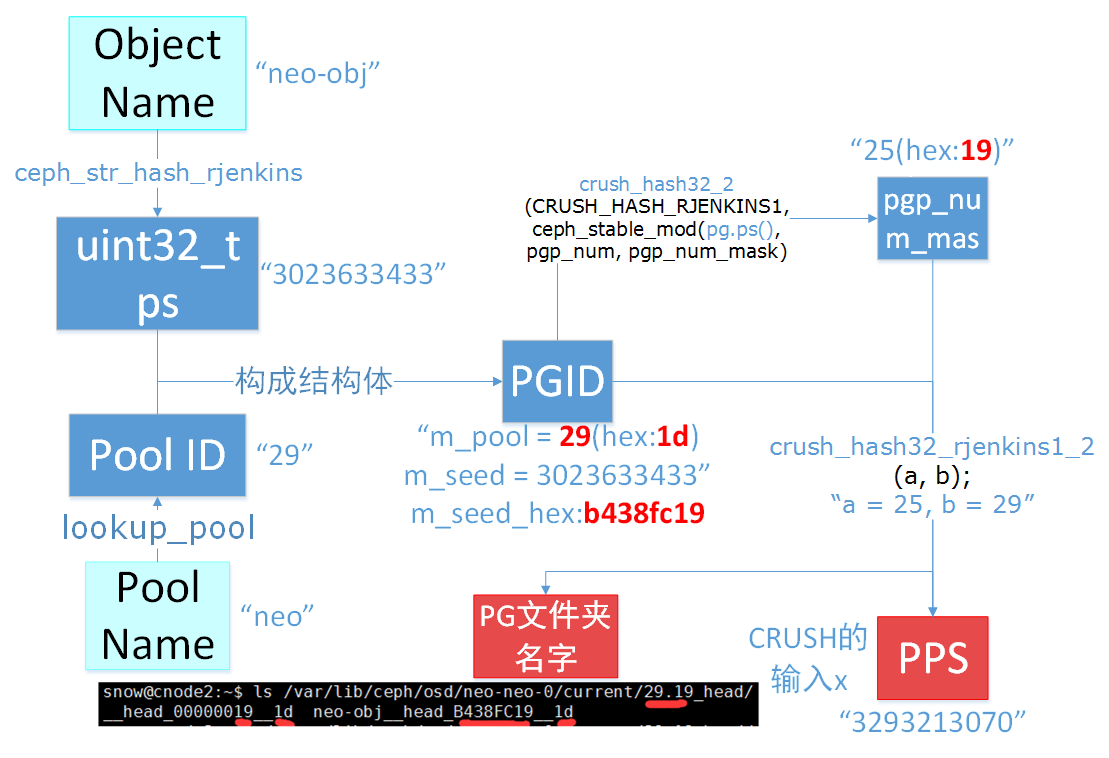
P.S. you can find something in PG’s name and object name.
2.2 PGID —> OSD set
首先需要明白几个概念
weight VS reweight
这里,“ceph osd crush reweight” 设置了OSD的权重weight
这个重量为任意值(通常是磁盘的TB大小,1TB设置为1),并且控制系统尝试分配到OSD的数据量。reweight
reweight将覆盖了weight量。这个值在0到1的范围,并强制CRUSH重新分配数据。它不改变buckets 的权重,并且是CRUSH不正常的情况下的纠正措施。(例如,如果你的OSD中的一个是在90%以上,其余为50%,可以减少权重,进行补偿。)
primary-affinity
主亲和力默认为1(即,一个OSD可以作为主OSD)。primary-affinity变化范围从0到1.其中0意味着在OSD可能用作主OSD,设置为1则可以被用作主OSD.当其<1时,CRUSH将不太可能选择该OSD作为主守护进程。
- PG VS PGP
http://lists.ceph.com/pipermail/ceph-users-ceph.com/2015-May/001610.html
pg 和 pgp的区别
- PG = Placement Group
- PGP = Placement Group for Placement purpose
- pg_num = number of placement groups mapped to an OSD
当增加每个pool的pg_num数量时,每个PG分裂成半,但他们都保持到它们的父OSD的映射。
直到这个时候,ceph不会启动平衡策略。现在,当你增加同一池中的pgp_num值,PGs启动从父OSD迁移到其他OSD,ceph开始启动平衡策略。这是PGP如何起着重要的作用的过程。
pgp-num是在CRUSH算法中使用的参数,不是 pg-num.例如pg-num = 1024 , pgp-num = 1.所有的1024个PGs都映射到同一个OSD.当您增加PG-NUM是分裂的PG,如果增加PGP-NUM将移动PGs,即改变OSD的map。PG和PGP是很重要的概念。
void do_rule(int rule, int x, vector<int>& out, int maxout,
const vector<__u32>& weight) const {}在了解了这些概念后开始第二部分
PGID -> OSD set. 现在我们在 do_rule: void do_rule(int rule, int x, vector<int>& out, int maxout, const vector<__u32>& weight)
do_rule源代码
void do_rule(int rule, int x, vector<int>& out, int maxout,
const vector<__u32>& weight) const {
Mutex::Locker l(mapper_lock);
int rawout[maxout];
int scratch[maxout * 3];
int numrep = crush_do_rule(crush, rule, x, rawout, maxout, &weight[0], weight.size(), scratch);
if (numrep < 0)
numrep = 0;
out.resize(numrep);
for (int i=0; i<numrep; i++)
out[i] = rawout[i];
}
让我们看下输入参数
x 就是我们已经得到的 pps rule 就是内存中的crushrule’s number(不是 ruleid, 在我的crushrule set中, this rule’s id是 3), weight 是已经讲过的 reweight 变化范围从1 到 65536. 我们定义了 rawout[maxout] 来存储 OSD set, scratch[maxout * 3] 为计算使用. 然后我们进入了crush_do_rule.
PGID -> OSDset OUTLINE
下面要仔细研究3个函数, firstn 意味着副本存储, CRUSH 需要去选择n
个osds存储副本. indep是纠删码存储过程.我们只关注副本存储方法
crush_do_rule: 反复do crushrulescrush_choose_firstn: 递归选择特定类型的桶或设备crush_bucket_choose: 直接选择bucket的子节点
crush_do_rule
首先这是我的crushrule 和集群的层次结构
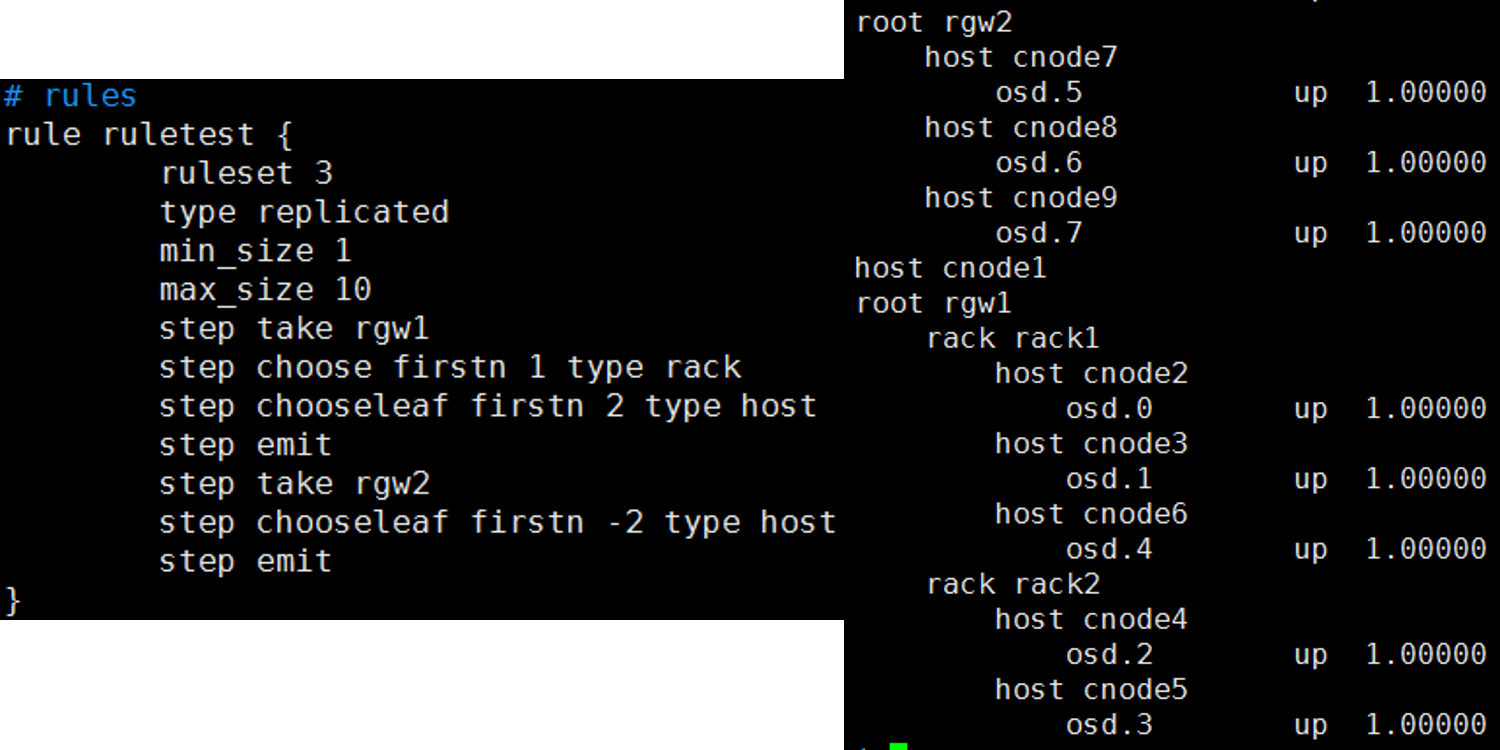
参数
@map: the crush_map
@ruleno: the rule id
@x: hash input
@result: pointer to result vector
@result_max: maximum result size
@weight: weight vector (for map leaves)
@weight_max: size of weight vector
@scratch: scratch vector for private use; must be >= 3 * result_max
int crush_do_rule(const struct crush_map *map,
int ruleno, int x, int *result, int result_max,
const __u32 *weight, int weight_max,
int *scratch)值得说的变量emit 通常用在规则的结束,同时可以被用在在形相同规则下选择不同的树.更多详细信息看官网
http://docs.ceph.com/docs/master/rados/operations/crush-map/#crush-map-rules
scratch[3 * result_max]
int *a = scratch;
int *b = scratch + result_max;
int *c = scratch + result_max*2;a, b, c 分别指向 scratch向量的0, 1/3, 2/3的位置.
w = a; o = b;
- w被用作一个先入先出队列来在CRUSH map中进行横向优先搜索(BFS traversal).
- o存储crush_choose_firstn选择的结果.
- c存储最终的OSD选择结果.
crush_choose_firstn计算后如果结果不是OSD类型, o 交给w.以便于 w成为下次crush_choose_firstn的输入参数. 如上所述, crush_do_rule 反复进行 crushrules 迭代. 你可以在内存中发现规则:
过程步骤
step 1 put root rgw1 in
w(enqueue);step 2 would run crush_choose_firstn to choose 1 rack-type bucket from root rgw1
下面分析crush_choose_firstn过程
crush_choose_firstn 函数
这个函数递归的选择特定bucket或者设备,并且可以处理冲突,失败的情况.
如果当前是choose过程,通过调用crush_bucket_choose来直接选择.
如果当前是chooseleaf选择叶子节点的过程,该函数将递归直到得到叶子节点.
crush_bucket_choose 函数
crush_bucket_choose是CRUSH最重要的函数.应为默认的bucket类型是straw,常见的情况下我们会使用straw类型bucket,然后就会进入bucket_straw_choose
case进行跳转
case CRUSH_BUCKET_STRAW:
return bucket_straw_choose((struct crush_bucket_straw *)in,完整代码
static int crush_bucket_choose(struct crush_bucket *in, int x, int r)
{
dprintk(" crush_bucket_choose %d x=%d r=%d\n", in->id, x, r);
BUG_ON(in->size == 0);
switch (in->alg) {
case CRUSH_BUCKET_UNIFORM:
return bucket_uniform_choose((struct crush_bucket_uniform *)in,
x, r);
case CRUSH_BUCKET_LIST:
return bucket_list_choose((struct crush_bucket_list *)in,
x, r);
case CRUSH_BUCKET_TREE:
return bucket_tree_choose((struct crush_bucket_tree *)in,
x, r);
case CRUSH_BUCKET_STRAW:
return bucket_straw_choose((struct crush_bucket_straw *)in,
x, r);
case CRUSH_BUCKET_STRAW2:
return bucket_straw2_choose((struct crush_bucket_straw2 *)in,
x, r);
default:
dprintk("unknown bucket %d alg %d\n", in->id, in->alg);
return in->items[0];
}
}/* straw */
static int bucket_straw_choose(struct crush_bucket_straw *bucket,
int x, int r)
{
__u32 i;
int high = 0;
__u64 high_draw = 0;
__u64 draw;
for (i = 0; i < bucket->h.size; i++) {
draw = crush_hash32_3(bucket->h.hash, x, bucket->h.items[i], r);
draw &= 0xffff;
draw *= bucket->straws[i];
if (i == 0 || draw > high_draw) {
high = i;
high_draw = draw;
}
}
return bucket->h.items[high];
}
bucket结构体
struct crush_bucket_straw {
struct crush_bucket h;
__u32 *item_weights; /* 16-bit fixed point */
__u32 *straws; /* 16-bit fixed point */
};
可以看到 bucket root rgw1’s id是 -1, type = 10 意味着根节点 alg = 4 意味着 straw 类型. 这里 weight 是 OSD权重 we set scales up by 65536(i.e. 37 * 65536 = 2424832). 然后看下循环 T: 对每个输入的son bucket , 例如升上图rack1, crush_hash32_3 hashes x,bucket id(rack1’s id), r(current selection’s order number), 这3个变量是a uint32_t 类型变量, 结果 & 0xffff, 然后乘straw(rack1’s straw value, straw calculation seen below), 最后得到这个值, 在一次循环中, for one son bucket(rack1 here). 我们在循环中计算每个 son bucket然后选择最大的 . 然后一个son bucket 被选择 . Nice job! 下面是个计算的例子
调用层次,图表描述
过程是在设备树种的搜索过程
结论
我们已经研究了CRUSH计算中的重要部分,其余的部分就是迭代和递归,直到选择了所有的OSD.
关于 straw 值
详细的代码在 src/crush/builder.c crush_calc_straw.
总之,straw 值总是和OSD权重正相关.straw2正在开发.
参考
本文翻译自Jieyu Xue的文章
CEPH CRUSH algorithm source code analysis
on May 19, 2016 under Original
http://www.shalandis.com/original/2016/05/19/CEPH-CRUSH-algorithm-source-code-analysis/CEPH CRUSH algorithm source code analysis
http://www.shalandis.com/original/2016/05/19/CEPH-CRUSH-algorithm-source-code-analysis/
翻译原文
http://blog.csdn.net/xingkong_678/article/details/51590459





 本文详细分析了CEPH CRUSH算法的工作原理和源码执行流程,通过调试介绍了从input到PGID,再到OSD set的计算过程。读者需要对ceph的基本操作和源码有一定了解。文章阐述了如何编译CEPH,获取函数调用栈,并重点探讨了crush_choose_firstn和crush_bucket_choose等关键函数的作用。
本文详细分析了CEPH CRUSH算法的工作原理和源码执行流程,通过调试介绍了从input到PGID,再到OSD set的计算过程。读者需要对ceph的基本操作和源码有一定了解。文章阐述了如何编译CEPH,获取函数调用栈,并重点探讨了crush_choose_firstn和crush_bucket_choose等关键函数的作用。





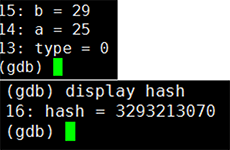
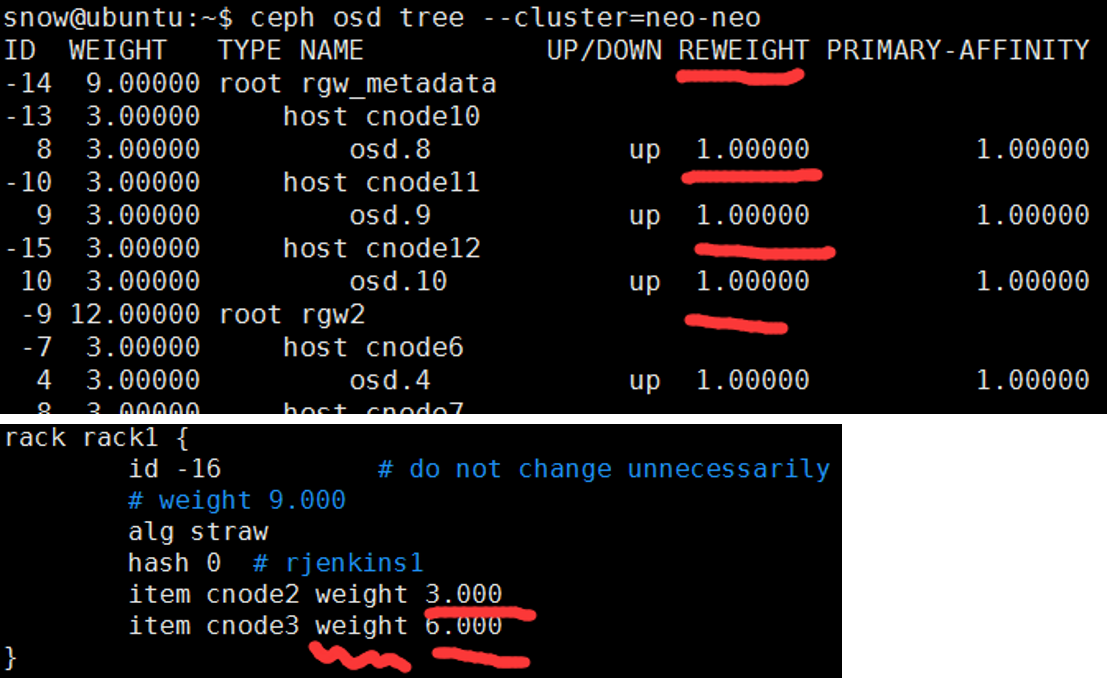


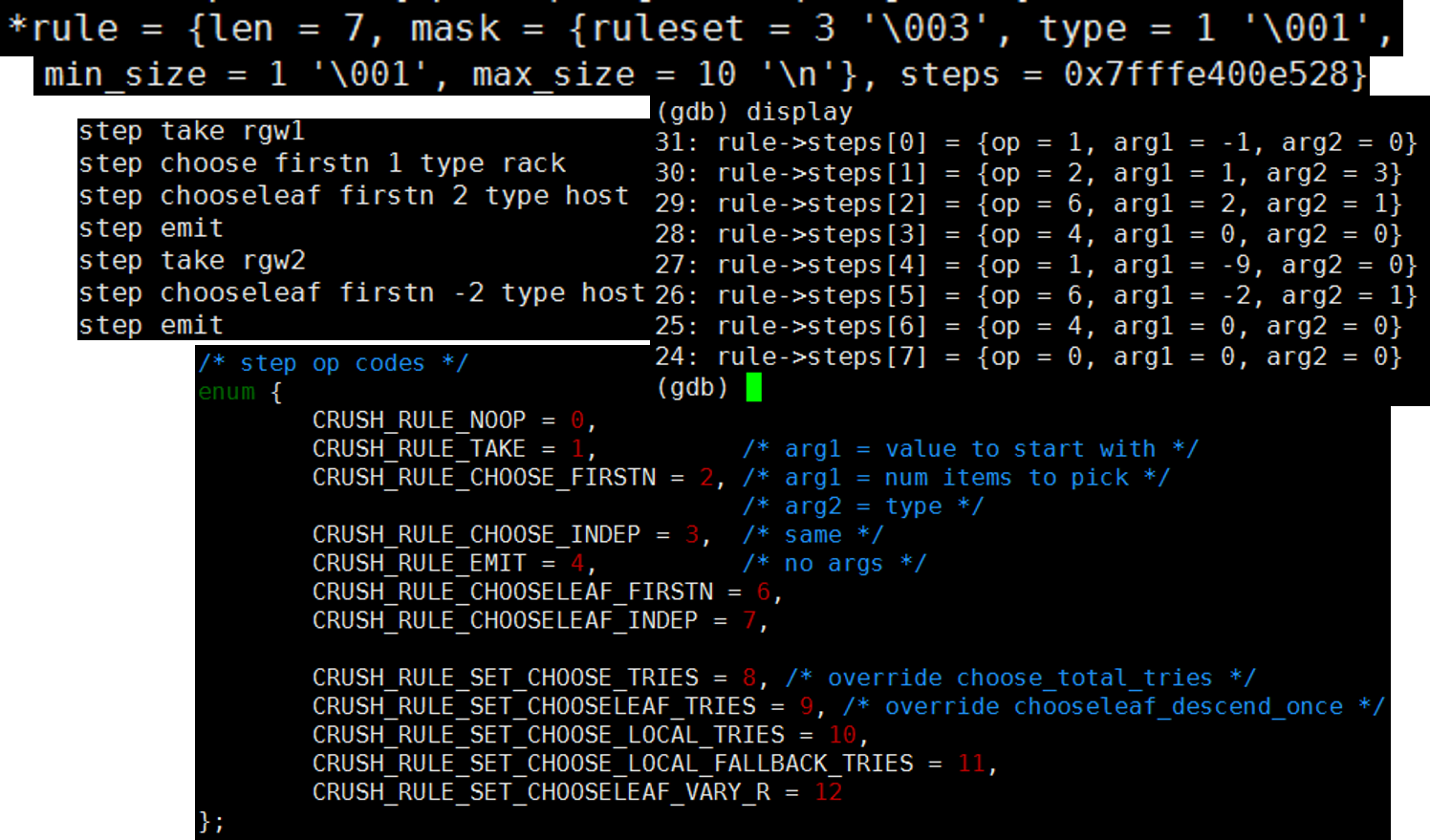
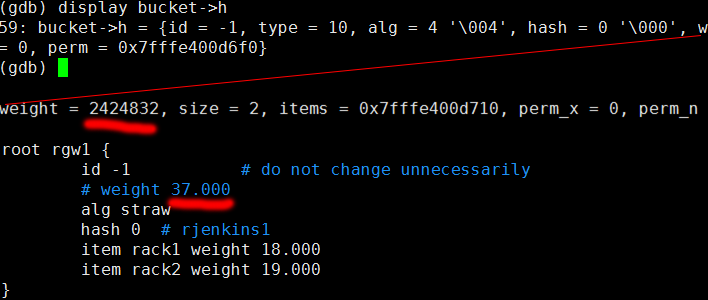
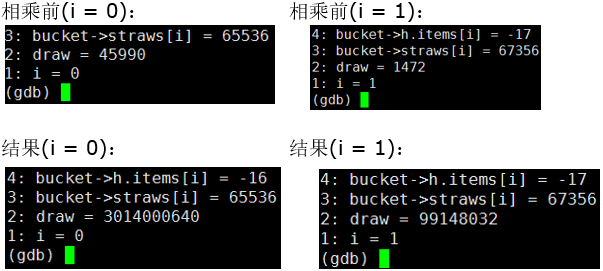


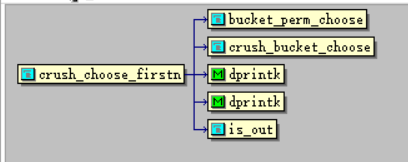
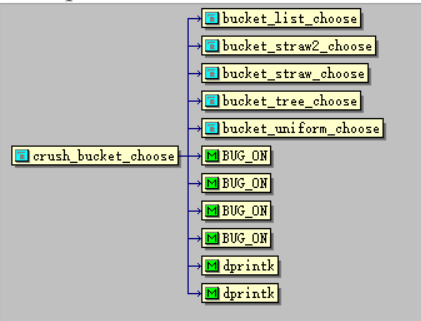


















 1604
1604

 被折叠的 条评论
为什么被折叠?
被折叠的 条评论
为什么被折叠?








